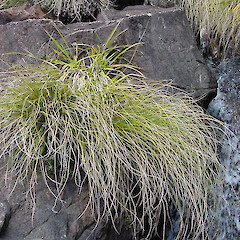Chionochloa defracta
Common name
Red Hills snow tussock
Synonyms
None (first described in 1991)
Family
Poaceae
Flora category
Vascular – Native
Endemic taxon
Yes
Endemic genus
No
Endemic family
No
Structural class
Grasses
NVS code
The National Vegetation Survey (NVS) Databank is a physical archive and electronic databank containing records of over 94,000 vegetation survey plots - including data from over 19,000 permanent plots. NVS maintains a standard set of species code abbreviations that correspond to standard scientific plant names from the Ngä Tipu o Aotearoa - New Zealand Plants database.
CHIDEF
Chromosome number
2n = 42
Current conservation status
The conservation status of all known New Zealand vascular plant taxa at the rank of species and below were reassessed in 2017 using the New Zealand Threat Classification System (NZTCS) – more information about this can be found on the NZTCS website. This report includes a statistical summary and brief notes on changes since 2012 and replaces all previous NZTCS lists for vascular plants.
Please note, threat classifications are often suggested by authors when publications fall between NZTCS assessment periods – an interim threat classification status has not been assessed by the NZTCS panel.
- Conservation status of New Zealand indigenous vascular plants, 2017 . 2018. Peter J. de Lange, Jeremy R. Rolfe, John W. Barkla, Shannel P. Courtney, Paul D. Champion, Leon R. Perrie, Sarah M. Beadel, Kerry A. Ford, Ilse Breitwieser, Ines Schönberger, Rowan Hindmarsh-Walls, Peter B. Heenan and Kate Ladley. Department of Conservation. Source: NZTCS and licensed by DOC for reuse under the Creative Commons Attribution 4.0 International licence.
2017 | At Risk – Naturally Uncommon | Qualifiers: RR, St
Previous conservation statuses
2012 | At Risk – Naturally Uncommon | Qualifiers: RR
2009 | At Risk – Naturally Uncommon
2004 | Range Restricted
Distribution
Endemic. New Zealand: South Island (mineral belt of Nelson and Marlborough).
Habitat
Upper montane to alpine. An ultramafic endemic which often is the dominant species within grassland. Also in scrub, and open forest or on ultramafic scree.
Detailed description
Tussocks of variable stature, some robust with long leaves, others slender with shorter, narrow leaves; culm internodes hairy; leaves stiff, scabrid, deciduous. Leaf-sheath to 250 mm, fracturing into short segments, shining light brown at base, long (4 mm) and short deciduous inter-rib hairs above, margin long hairy above, apical tuft of hairs to 4 mm. Ligule to 0.8 mm. Leaf-blade to 750 × 1.3 mm diameter, acicular rush-like, midrib evident, falling with part of sheath, abaxially with long hairs aside midrib below becoming very scabrid above, adaxially with weft of long hairs at base, abundant prickle-teeth and papillae above; margin thick, below with long (up to 4 mm) hairs interlocking across leaf-blade, scabrid above. Culm to 650 mm; lower internodes densely hairy, less so above, hairy below inflorescence. Inflorescence to 200 mm, narrow and strict, very scabrid and with a few long hairs at branch axils and below spikelets. Spikelets of up to 6 lightly purpled florets. Glumes acute or shortly awned, scabrid above, less than or equal to adjacent lemma lobes; lower to 11 mm, 3-nerved, upper to 13 mm, 5–7-nerved. Lemma to 5.5 mm; hairs dense at margin and aside central nerve, often in all internerves or sometimes few or absent, greater than or equal to sinus; lateral lobes to 4.5 mm including awn to 2 mm, or acute, scabrid above; central awn to 11 mm from 2.5 mm twisting column. Palea to 8 mm. Callus to 1 mm, hairs to 4 mm. Rachilla to 1 mm, very occasionally short hairy. Lodicules to 1 mm. Anthers to 3.5 mm. Ovary to 1 mm; stigma-styles to 3.5 mm. Seeds to 3.5 mm.
Manaaki Whenua Online Interactive Key
Life cycle
Florets are wind dispersed (Thorsen et al., 2009).
Threats
Not Threatened. Listed because it is a naturally uncommon, regional endemic.
Etymology
chionochloa: Snow grass
Where To Buy
Not commercially available.
Attribution
Description modified from Edgar and Connor (2000).
References and further reading
Edgar E, Connor HE. 2000. Flora of New Zealand. Vol. V. Grasses. Christchurch, Manaaki Whenua Press. 650 p.
Thorsen MJ, Dickinson KJM, Seddon PJ. 2009. Seed dispersal systems in the New Zealand flora. Perspectives in Plant Ecology, Evolution and Systematics 11: 285–309.








